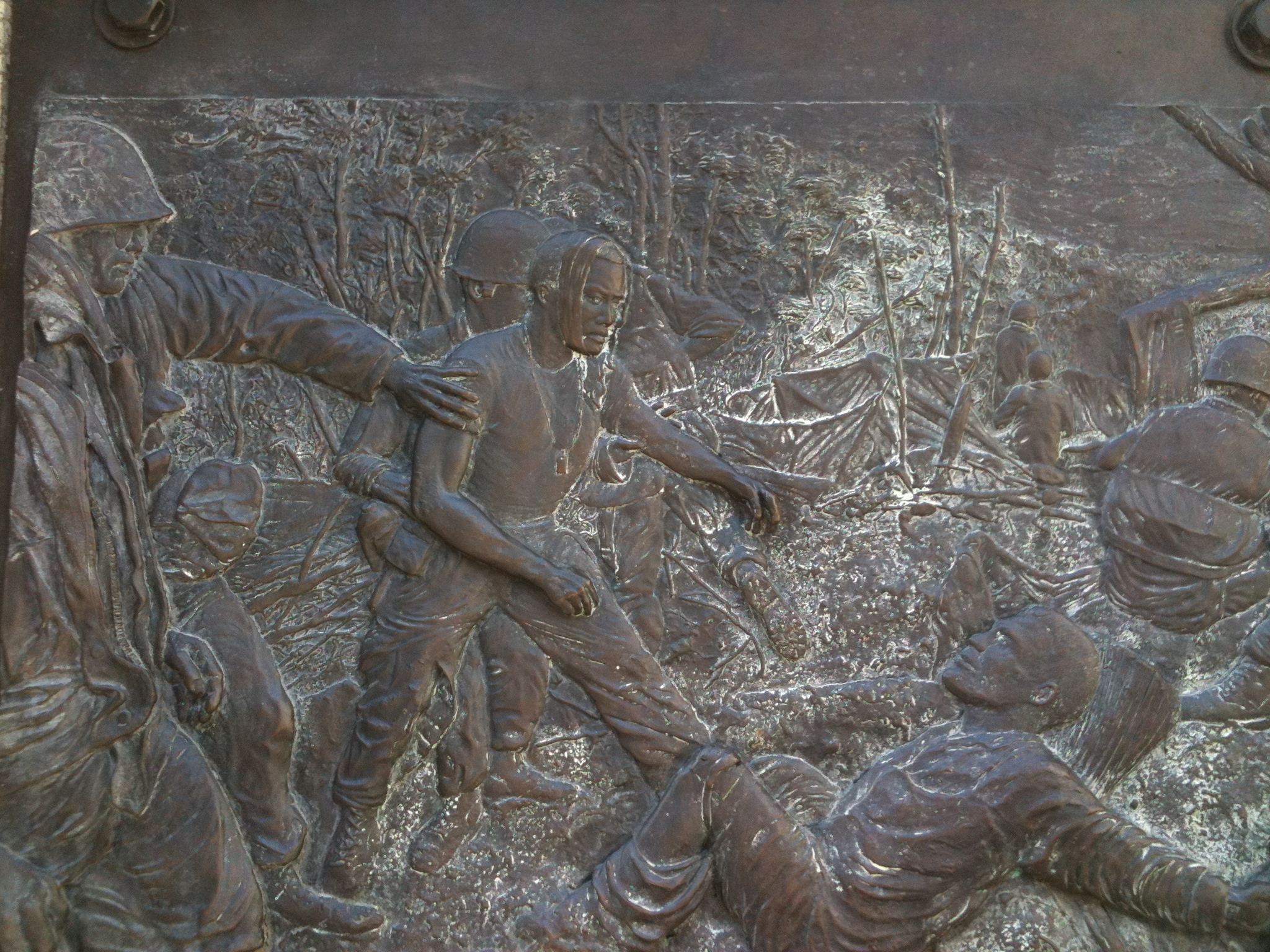The blossoms of the weeping cherry trees that encircle the 3,750 square-foot California Vietnam Veterans Memorial bloom in April and are reportedly a spectacular site (1). The memorial sits just beyond the rose garden in the north-east corner of Capitol Park, near 15th Street and Capitol Avenue. At the entrance to the memorial, visitors first pass the bronze map of South Vietnam.
Dedicated on December 10, 1988 the memorial was created by artist, Rolf Kriken, and was built entirely from over 2 million dollars donated for the project (2).
A quote from a still-photo video on YouTube describes the circular design and symbolism of the memorial:
“The memorial is designed in the shape of broken concentric circles to serve as a reflection on life. The innermost circle is shaped like a drum with entrances at the four points of the compass.”(3)
Pylons at the entrances are capped with electric lamps lit 24-hours a day to represent Eternal Flames.
Twenty-two black granite panels in the outer ring are engraved with the names of the 5,822 Californians who died or are MIA in the Vietnam war. The names are arranged by hometown. The day before Memorial day, an event called The Reading of the Names occurs where volunteers read all of the names on the memorial walls (4). Reading the nearly 6,000 names takes about 12 hours.
Lt. Gregory Hodson died in 1964 when his plane crashed into the South China Sea but, because the plane crashed just a few miles outside of the war zone, his name is not on this wall. It was the policy of the Navy to only put names on the wall of soldiers killed inside the war zone. Recently, through the 20-year effort of his good friend, Bill Spurgin, a memorial stone for Lt. Gregory was laid near the memorial (5).
The inside walls are full relief bronze sculptures of scenes from daily life during the war from the perspective of combat soldiers, nurses, and POWs. The California Vietnam Veterans Memorial was the first Vietnam war memorial to honor the experience and service of POWs and nurses (6). To get a felt sense of walking through the memorial, click to watch this video.
Flanking each relief are six bronze panels (three on each side); most depicting images from well-known photographs from the war. The US Constitution and Bill of Rights are also depicted in their own panels.
A bronze sculpture of a combat soldier reading a letter from his parents sits in the inner circle of the memorial.
Next to the soldier sits a bronze plaque with a poem by Major Michael O’Donnell.
The poem reads:
Take what they have left
and what they have taught you
with their dying
and keep it with your own.
And in that time
where men decide and feel safe
to call the war insane,
take one moment to embrace
those gentle heroes
you left behind.
Memorials to honor the men and women who serve are important places for recognition, reflection, respect, and remembering. Another vitally important aspect of honoring those who serve is providing support services for their return to civilian life, particularly those who have been injured physically and emotionally.
My uncle, Kirk Bauer, served in Vietnam. He was awarded the Bronze Star twice, a Metal of Valor, and a Purple Heart for injuries sustained in combat. In 1969 he was a noncommissioned officer in the Army and lost his leg in a grenade explosion. During his rehabilitation, fellow veterans approached him proposing to they teach him to ski. Kirk went on to become a member of the U.S. Disabled Ski Team and was one of the first disabled ski instructors to be fully certified by the Professional Ski Instructors of America. This small group of veterans skiing in the 1960s was the beginning of what would later become Disabled Sports USA (DS/USA), the organization Kirk has headed since 1982.
DS/USA is a “nationwide sports rehabilitation programs that is available to anyone with a permanent disability. Activities include winter skiing, water sports, summer and winter competitions, fitness and special sports events.” (7). Their programs are available to anyone, but they actively support wounded veterans returning from war to get them involved in the programs and this can make all the difference in the wounded soldier’s life. A quote on the DS/USA website from a veteran says it all:
When I’m out there boarding, it takes the disability away from my mind and gives me more of my freedom. I’m enjoying what I went to protect. I owe a lot to this program. It saved my life. (8)
If you would like to make a donation to DS/USA, you can click here to use their secure online form.
Title: California Vietnam Veterans Memorial
Artist: Rolf Kriken (http://www.nordhammer.com/gallery/kriken_about.htm)
Date: 1988
Media: Bronze
Location: Capital Park
View Pedestrian Art, Sacramento in a larger map
(1) http://www.youtube.com/watch?v=dtBvOLZ_IA4
(2) http://www.vva.org/veteran/1208/CA_memorial.html
(3) http://www.youtube.com/watch?v=dtBvOLZ_IA4
(4) http://www.norcaltrav.com/vietnam_veterans_memorial_-sac.htm
(5) http://sacramento.cbslocal.com/2011/02/19/47-years-later-vietnam-vet-memorialized-in-sacramento/
(6) http://1banchie.tripod.com/banchie11.html
(7) http://www.dsusa.org/about-overview.html
(8) https://dsusa.org/donate.html














































